Much of the action in the electric vehicle space has been revolving around the luxury passenger vehicle segment. The marketing concept being, buyers of luxury BEVs are more environment-conscious, and their demand is price inelastic. But the future of electric mobility depends on mass-adoption and that needs true democratisation in the BEV segment.
EVs are currently more expensive than their ICE (internal combustion) counterparts, but that it likely to even out over the next few decades. Lithium-ion battery prices have been declining and the trend is likely to continue. Yet, the current choices in the affordable BEV category are extremely limited. There is more to come, but till recently, you’d have had to choose between the Tata Tiago.ev or the Citroen eC3.
In the next few weeks, you will have a third choice in the MG Comet EV. Can this be the disruptor in the mass-market EV segment? Is the Comet EV too early for its times? To find out, I travelled to Gurugram for the national media test drive of the new Comet.
Design
Before the onset of the EV era, I remember attending global auto shows where electric concepts would often be these sci-fi, self-driving pods that were being showcased as the inevitable future of urban personal mobility solutions. The MG Comet EV at first glance has the same vibe.
So, its boxy, functional, yet futuristic design evokes a mix of nostalgia and incredulity. Nostalgia because it is uneasily similar to those concepts and incredulity because it doesn’t bode well for the future of design... and it is happening now. As a result, the design of the Comet is going to elicit polarising opinions. The complete absence of a bonnet, and the passenger cell being all the car there is, while that is the perfect leverage of an electric vehicle platform, it is also going to be radical breakaway from traditional car design. As such it is likely to be a difficult transition for a lot of buyers.
To put that design in perspective, here are some more facts about the Comet EV. It is a 3-door, so no separate doors for rear passengers. It is also a 4-seater and there are only two fixed large rear quarter glass instead of an openable glass window. This means that the rear two passengers have to get into the Comet EV via the front doors. Thankfully, the front two doors are wide enough to allow a certain degree of ease while doing that.

There are somewhat purposeful lines that MG designers have attempted despite the Comet’s rather simplistic structure. The rake of the A-pillar effectively starts from the edge of the front fender. The other line that emerges from the fender creates a crease that runs over the wheels and rises up past the rear quarter glass.
The front of the MG Comet also features LED headlamps and another LED DRL strip that sits in the middle of a black housing that connects both the door mirrors. There is also the backlit MG logo on the charging port door that lights up every time a door is opened.
The rear of the Comet EV sports a nearly completely upright tailgate. The small curve at the bottom makes the rear almost mimic the design at the front. There is also a LED strip in a black housing that’s right below the rear glass. The tail lamps are designed to match the headlamps in configuration. There is a thin panel, almost looking like a spoiler panel, at the front that sits just below the windscreen and pops open to give access to some serviceable parts and liquid top-ups like washer fluid.
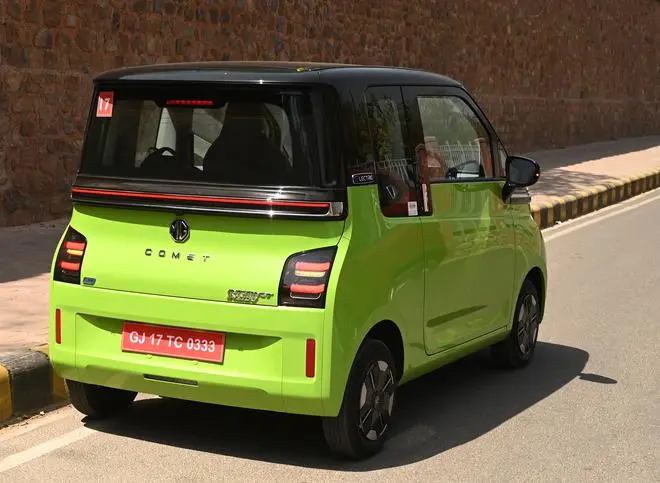
Rear view of Comet
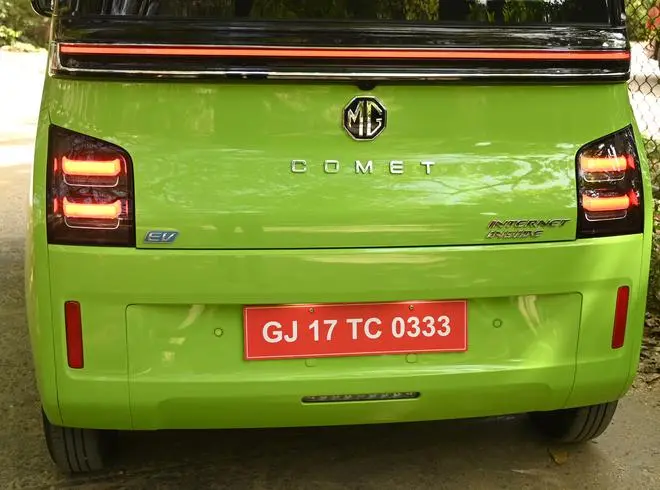
Rear view of Comet
Overall, the design of the Comet EV is radical, yet it also seems fragile. The design still sticks out like a concept, but I agree it might as yet be a perception that could turn over time. Some of that probably comes in from the oversimplified construction and the small 12-inch rims. While some big doubts remain about the Comet EV’s highway worthiness, the good bit is that MG Motor is clear about pitching this as an urban commuter only. The target audience is the young, eco-conscious millennial who wants a runabout and who would’ve taking public transport otherwise.
Cabin
Forget sub-four-metre, the Comet EV is sub-three-metre in length. The wheelbase is just about two metres and the width is just five feet or 1.5 metres; so this really is a micro car. The one good feature about the Comet EV is the way its rectangular pod-like design and the upright panels allow it to do an excellent leverage of cabin space versus exterior footprint. So, it was a pleasant surprise to find that the interior of the Comet EV is not as cramped as it would seem.
But its narrow track means the amount of shoulder room you get is still lesser than most small ICE cars. It is a 4-seater and there’s barely 3-4 inches of spare shoulder room for adults. The legroom at the rear is however not too bad, though it is certainly not generous.
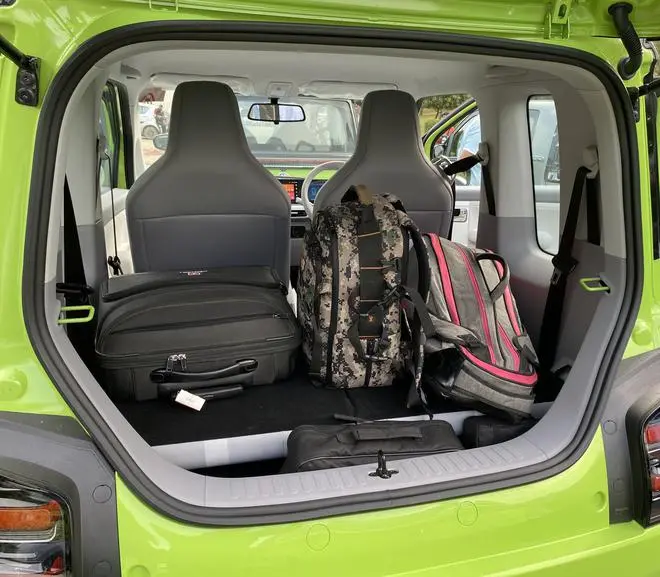
The construction of the seats is also quite simplistic and so the side bolsters and under thigh support isn’t much to talk about. With the battery pack position leading to a slightly raised floor, rear passengers will sit with their knees up. Overall, the Comet should be relatively comfortable for four adult passengers for short journeys like a daily commute.
The layout and construction of the dashboard and door panels are also a bit like the exterior - spartan, but not tacky. The dashboard is not really one in the traditional sense. It is like a floating unit, without a centre stack or gear stick housing, there is no extension to the floor. Instead, there is a rotary selector that sits on top of what looks like an appendage between the driver and front passenger seats. This also sports the power-window buttons for the front two doors.
The steering wheel is a simple two-spoke unit with controls for the audio system and voice command function. Finish quality for the steering is decent, with its stitched leatherette wrap and gadget like scrolling wheel controls. The light grey interior theme with its white plastic elements helps elevate the cabin from seeming too plasticky. The dash has a small patch of fabric insert and there are a few chrome elements including the door handles, the MG logo, the rotary selector knob, and the aircon vent frames.
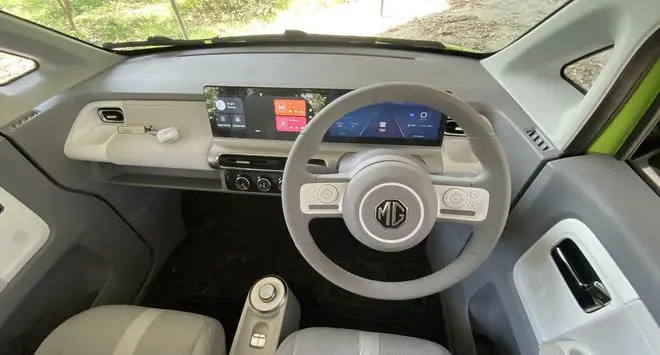
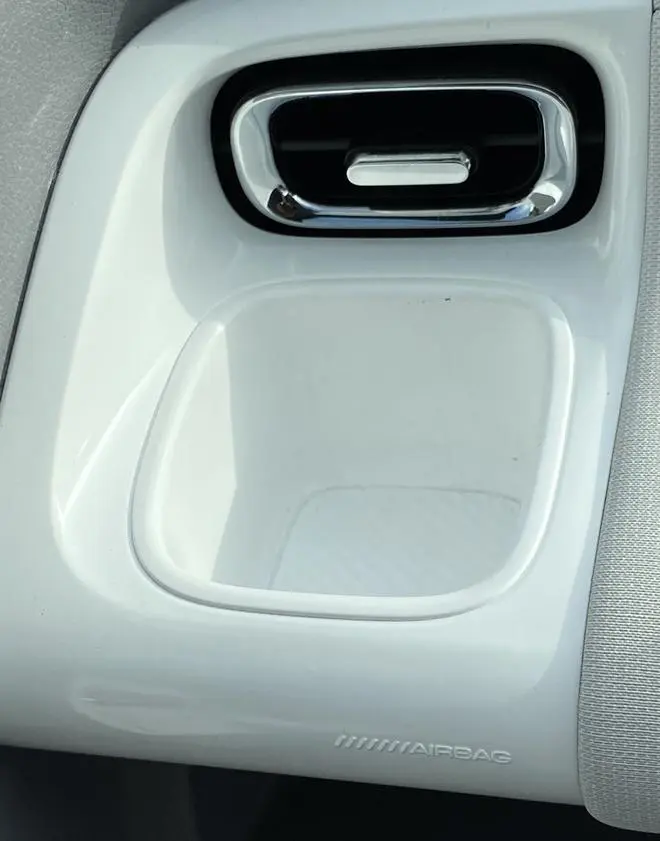
The most dominant element in the cabin is the 26cm long digital screen that combines the infotainment and instrument displays. It gets wireless Apple CarPlay and Android Auto connectivity and is the most visible bit of hi-tech gadgetry in the cabin. The digital instrument displays the typical EV drive-related info like state-of-charge, driving range, driving mode chosen, and a real-time graphical depiction of the energy consumption and recuperation.
The one-change in real-time info I expected to see, but couldn’t was a change in driving range based on driving mode change. There are three driving modes to chose from - Eco, Normal and Sport. There is no cruise control, what with the Comet EV being pitched as a urban daily commuter.
But it still gets some nifty features like an intelligent key, a smart start system, where all you need to do is tap the brake pedal twice for it to get into standby mode, power-adjustable door mirrors and follow me home headlamps. There are a few places where the savings shows, including the manual parking brake, and the absence of a creep function for the automatic gearbox. Throttle input is needed for both moving forward and reverse.
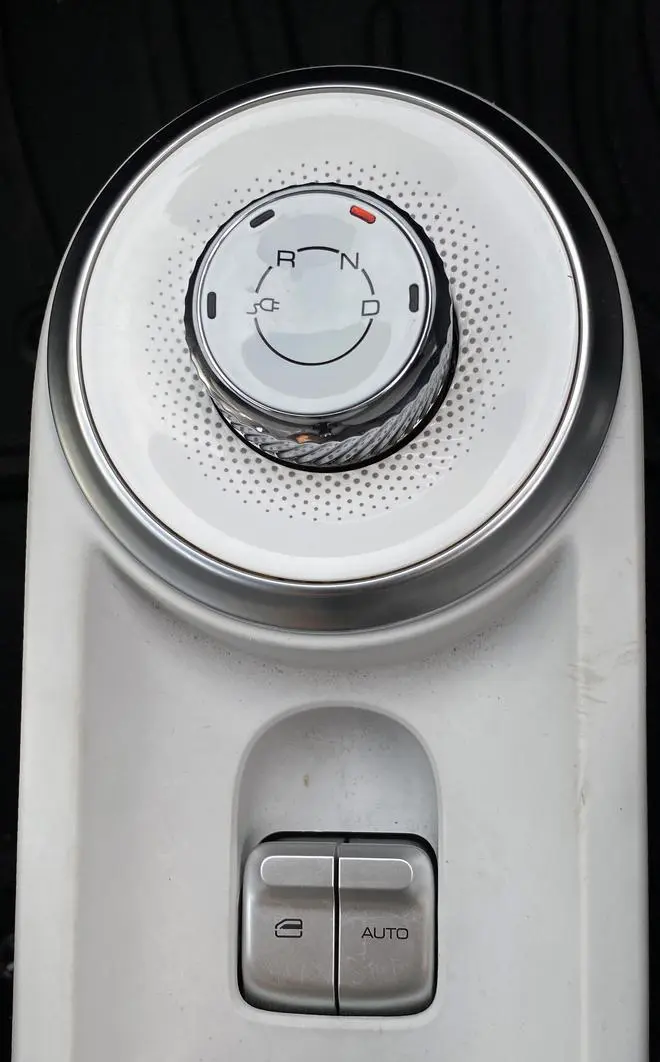
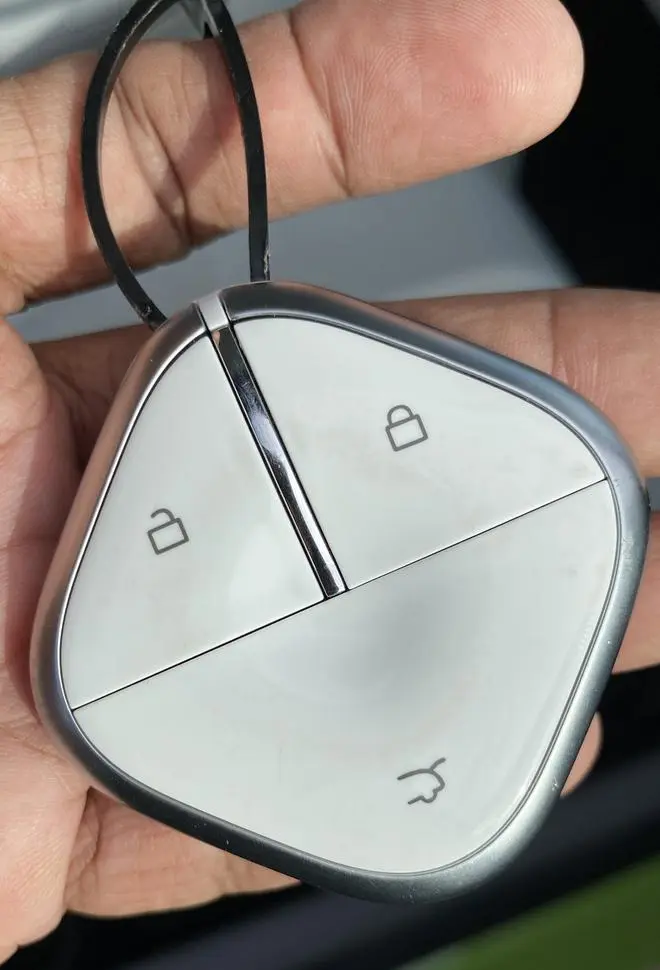
Comet’s intelligent key
But, in keeping with the progressive packaging needed for an electric, the Comet EV gets about 55 connected car features under MG’s i-Smart suite. The fact the front doors are big and open wide is an advantage. Yet, ingress and egress to the rear seat is not going to be easy for older passengers.
Battery-electric powertrain
The Comet EV packs a 17.3kWh LFP (Lithium Ferro Phosphate) battery under the floor. The pack consists of multiple prismatic cells, which MG claims to be the safer configuration for this battery chemistry. The pack powers a permanent magnet synchronous motor that generates 42PS of peak power and 110Nm of max torque. The torque is directed to the wheels via an automatic transmission.
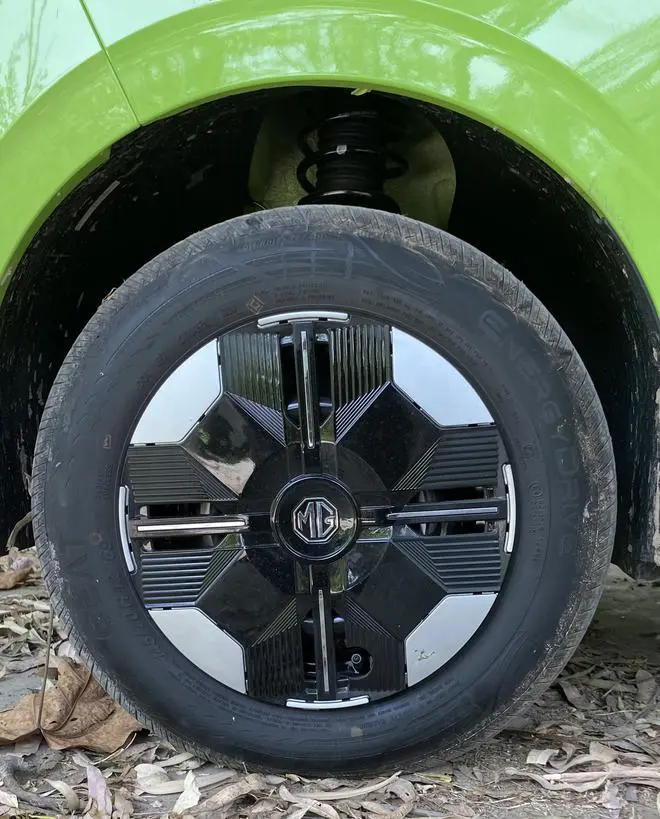
And the Comet’s rated driving range is about 230kms per charge. The Comet is not designed to deliver high-speed charging, though it will be compatible with any CCS2 charging socket in the charging ecosystem currently. MG claims that the 3.3kWh wall socket charging cable that it will provide with the Comet will take about seven hours for a full charge from zero, and about five hours for a 10-80 per cent charge.
MG has possibly shaved off some costs here too. But with the target audience being young commuters who would probably clock an average of 30kms every day, a full charge of the battery could potentially last a full working week. But if you are going to attempt a long drive across one of the large cities like Mumbai or the NCR, you might find yourself waiting a fair bit for juicing up the battery if it is running low on charge.
The other aspect about the battery is that brake energy recuperation is not very strong as to allow one pedal driving. The regenerative braking varies between the three driving modes. Regen braking is low in Eco mode and the Comet EV seems to cruise when I take my foot off the throttle. In sport mode, acceleration is better and regen braking is heavier too.
One of my quibbles about my test mule Comet was that while SOC displayed was consistent with my driving, the range displayed didn’t change even if changed driving modes. Driving range based on battery charge remaining should vary based on whether the Comet EV is being driven in Eco, Normal or Sport mode, and if the aircon is being used or not. Real world range is likely to be closer to 160-170kms and will vary based on driving conditions and driving style.
Ride and handling
The electric powertrain in the Comet EV is not a cracker. But combined with the vehicle’s light weight, the motor’s output is enough to give it a fair bit of go. It doesn’t deliver the typical instant torque character of EVs, but a more gradual yet linear level of acceleration. Weaving through traffic and some quick overtaking should be possible. The ride quality is however not like the average ICE hatch. The small 12-inch rims and the 145/70 R12 tyres can’t quite roll over bad tarmac with as much ease as larger rims can. The short wheelbase also makes the impact at the seat a bit harsher. It is capable of handling speed breakers with its ground clearance, though even these tend to throw up the Comet quite a bit. Its ride is best on clean, well-laid tarmac.
Bottom Line
For safety kit, the new Comet EV gets dual front airbags, ABS with EBD, and reverse parking camera and sensors. MG officials say that much of the chassis consists of high-strength, hot-stamped steel panels. There is also a tyre pressure monitoring system. Some of the features may vary depending on which of the three trim variants you choose. Personalisation options, including dual tone exterior paint, multiple stickers and wraps and a bunch of accessories to choose from.
MG Motor India has just announced a rather aggressive special introductory price of ₹7.98 lakh for the base variant of the Comet EV, making it the most affordable BEV in the market today. That starting price should help, though the Comet EV will still likely be appealing only to a niche audience. But MG is very clear with its expectations from the Comet and that is a good start for an EV which could eventually bring the disruption the market needs.




Comments
Comments have to be in English, and in full sentences. They cannot be abusive or personal. Please abide by our community guidelines for posting your comments.
We have migrated to a new commenting platform. If you are already a registered user of TheHindu Businessline and logged in, you may continue to engage with our articles. If you do not have an account please register and login to post comments. Users can access their older comments by logging into their accounts on Vuukle.